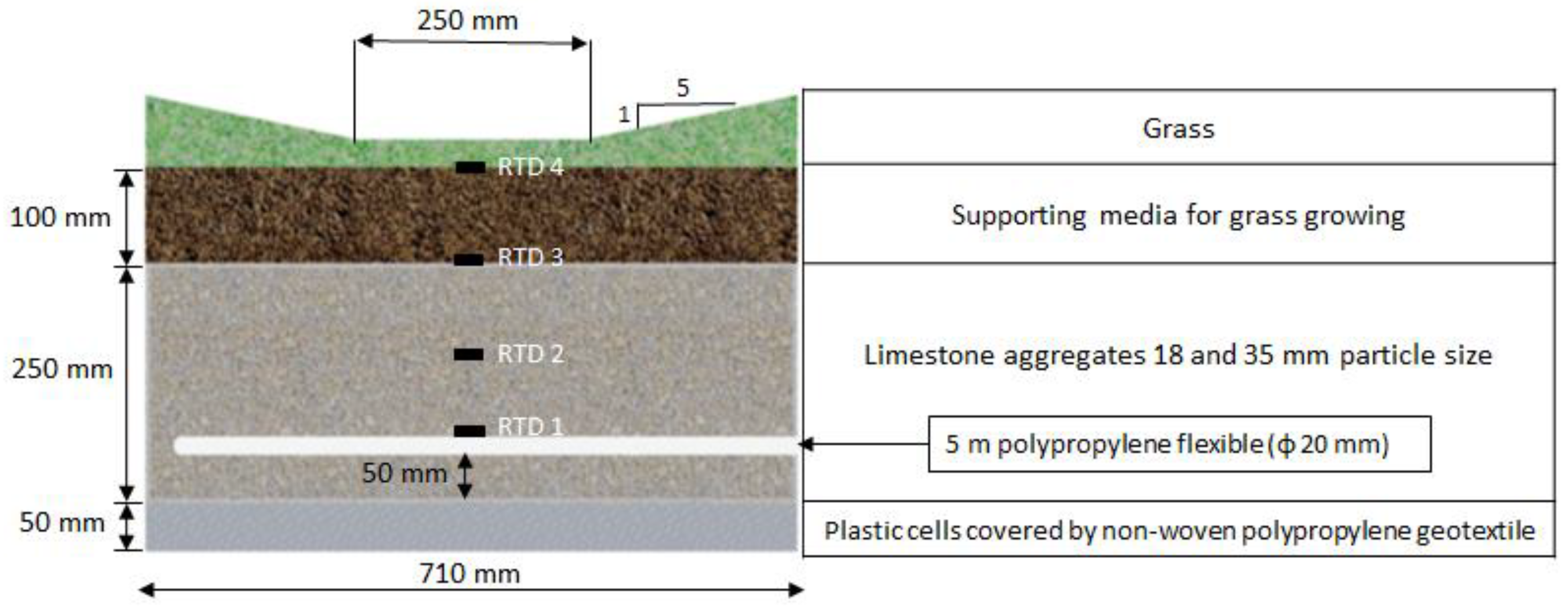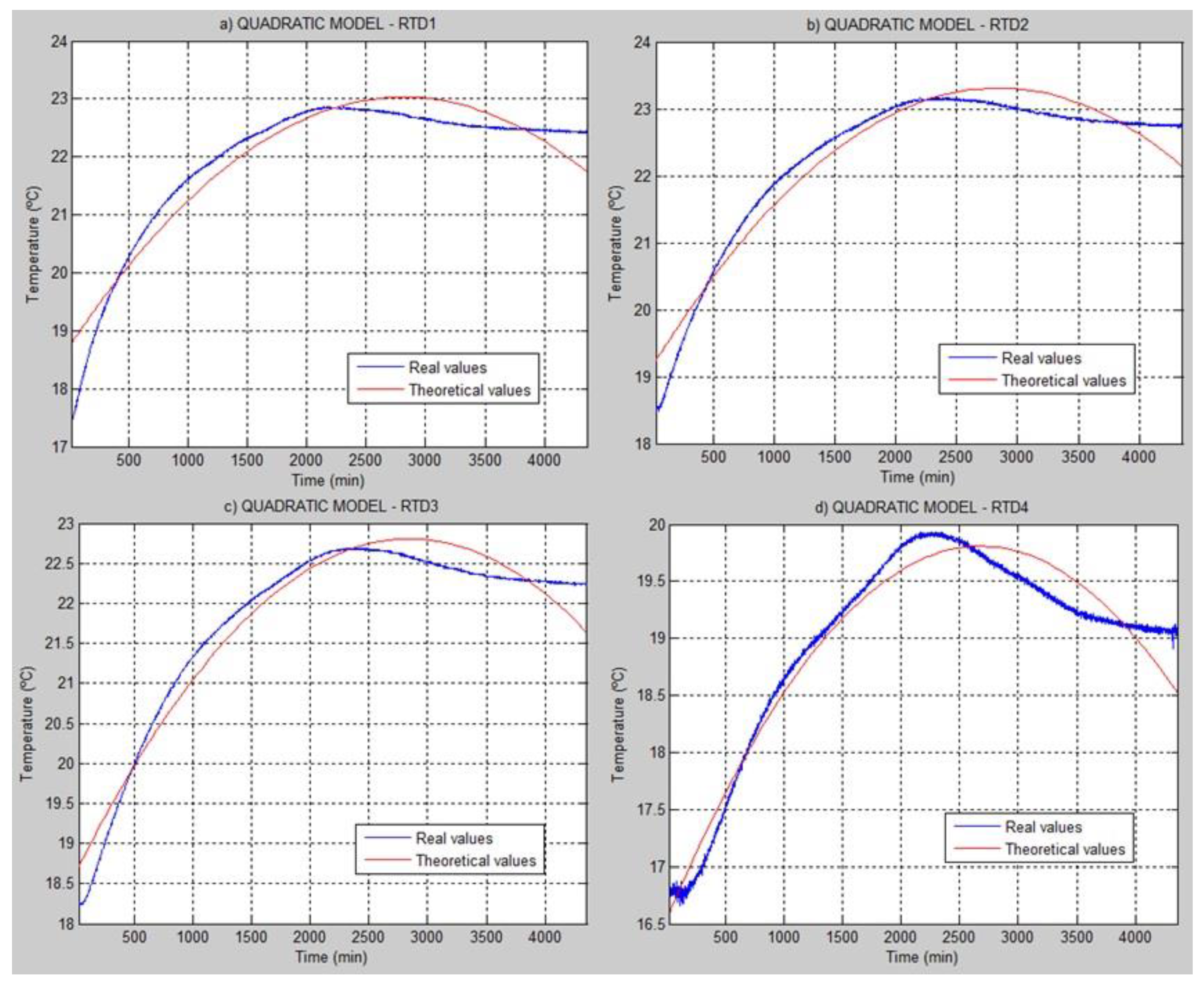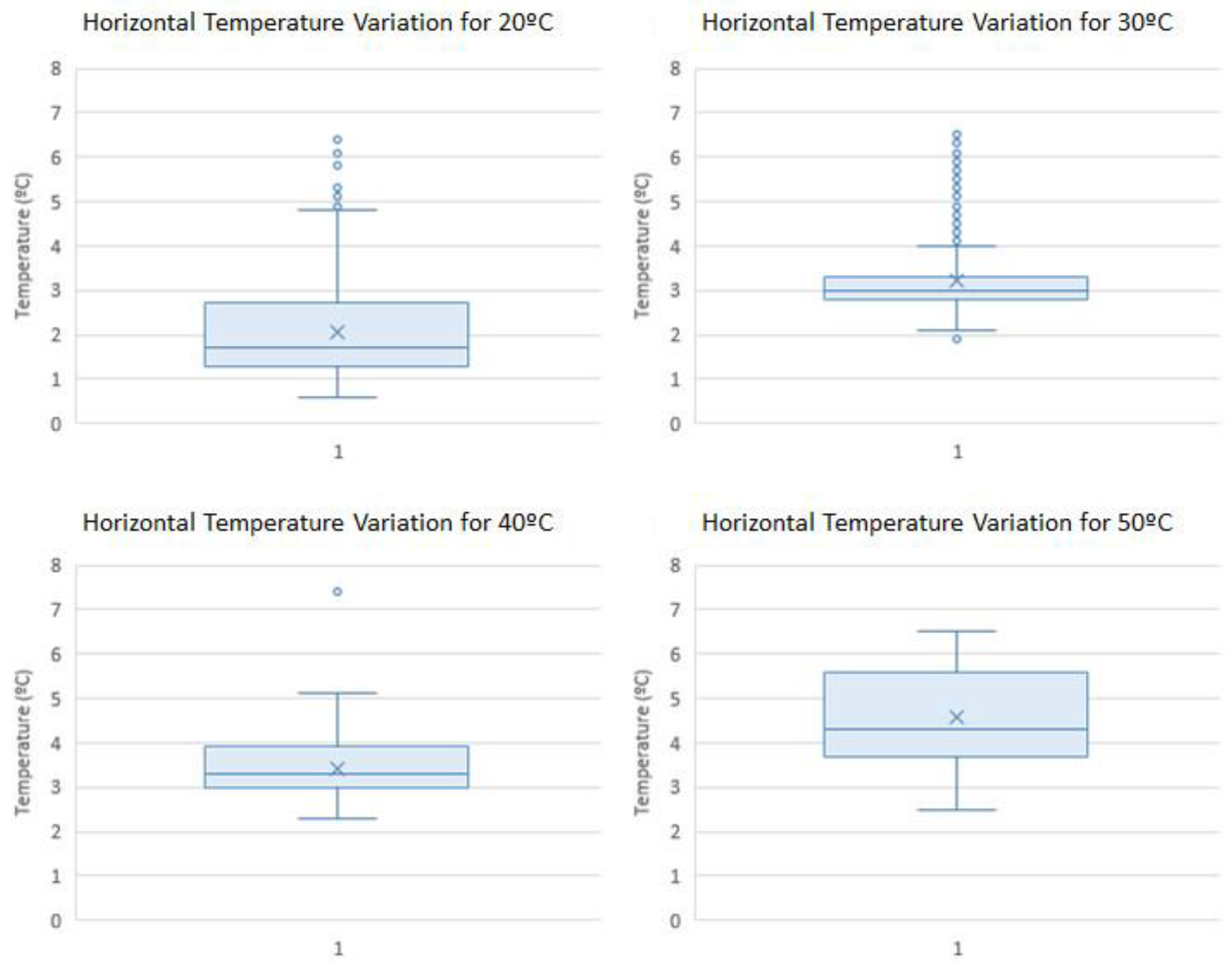Evaluating the Thermal Performance of Wet Swales Housing Ground Source Heat Pump Elements through Laboratory Modelling
Abstract
:1. Introduction
- Overall description of how the structure of a 1:2 scaled laboratory model for a wet swale responds under a range of temperatures (20 up to 50 °C) and consequent performance of the GSHP system;
- Development of behavioral models for the vertical and inlet/outlet temperature difference within the wet swale structure.
2. Materials and Methods
2.1. Materials and Experimental Set-Up
2.2. Experimental Methodology
3. Results and Discussions
3.1. Vertical Temperature Variation
3.2. Horizontal Thermal Variation
3.3. General Discussions and Future Research Directions
4. Conclusions
Author Contributions
Funding
Acknowledgments
Conflicts of Interest
References
- Li, Q.; Yu, Y.; Jiang, X.; Guan, Y. Multifactor-based environmental risk assessment for sustainable land-use planning in Shenzhen, China. Sci. Total Environ. 2019, 657, 1051–1063. [Google Scholar] [CrossRef] [PubMed]
- Chan, F.K.S.; Griffiths, J.A.; Higgitt, D.; Xu, S.; Zhu, F.; Tang, Y.-T.; Xu, Y.; Thorne, C.R. “Sponge City” in China—A breakthrough of planning and flood risk management in the urban context. Land Use Policy 2018, 76, 772–778. [Google Scholar] [CrossRef]
- Palazzo, E. From water sensitive to floodable: Defining adaptive urban design for water resilient cities. J. Urban Des. 2019, 24, 137–157. [Google Scholar] [CrossRef]
- Cai, D.; Fraedrich, K.; Guan, Y.; Guo, S.; Zhang, C. Urbanization and the thermal environment of Chinese and US-American cities. Sci. Total Environ. 2017, 589, 200–211. [Google Scholar] [CrossRef] [PubMed] [Green Version]
- Meerow, S.; Newell, J.P.; Stults, M. Defining urban resilience: A review. Landsc. Urban Plan. 2016, 147, 38–49. [Google Scholar] [CrossRef]
- Peña, L.; Onaindia, M.; Fernández de Manuel, B.; Ametzaga-Arregi, I.; Casado-Arzuaga, I. Analysing the Synergies and Trade-Offs between Ecosystem Services to Reorient Land Use Planning in Metropolitan Bilbao (Northern Spain). Sustainability 2018, 10, 4376. [Google Scholar] [CrossRef]
- La Rosa, D.; Privitera, R.; Barbarossa, L.; La Greca, P. Assessing spatial benefits of urban regeneration programs in a highly vulnerable urban context: A case study in Catania, Italy. Landsc. Urban Plan. 2017, 157, 180–192. [Google Scholar] [CrossRef]
- La Rosa, D. Accessibility to greenspaces: GIS based indicators for sustainable planning in a dense urban context. Ecol. Indic. 2014, 42, 122–134. [Google Scholar] [CrossRef]
- Pauleit, S.; Ambrose-Oji, B.; Andersson, E.; Anton, B.; Buijs, A.; Haase, D.; Elands, B.; Hansen, R.; Kowarik, I.; Kronenberg, J.; et al. Advancing urban green infrastructure in Europe: Outcomes and reflections from the GREEN SURGE project. Urban For. Urban Green. 2018, 40, 4–16. [Google Scholar] [CrossRef]
- Morison, P.J.; Brown, R.R. Understanding the nature of publics and local policy commitment to Water Sensitive Urban Design. Landsc. Urban Plan. 2011, 99, 83–92. [Google Scholar] [CrossRef]
- Perales-Momparler, S.; Andrés-Doménech, I.; Hernández-Crespo, C.; Vallés-Morán, F.; Martín, M.; Escuder-Bueno, I.; Andreu, J. The role of monitoring sustainable drainage systems for promoting transition towards regenerative urban built environments: A case study in the Valencian region, Spain. J. Clean. Prod. 2017, 163, S113–S124. [Google Scholar] [CrossRef]
- Gonzales, P.; Ajami, N.K. An integrative regional resilience framework for the changing urban water paradigm. Sustain. Cities Soc. 2017, 30, 128–138. [Google Scholar] [CrossRef] [Green Version]
- Cai, D.; Fraedrich, K.; Guan, Y.; Guo, S.; Zhang, C.; Zhu, X. Urbanization and climate change: Insights from eco-hydrological diagnostics. Sci. Total Environ. 2019, 647, 29–36. [Google Scholar] [CrossRef] [PubMed]
- Zhang, Z.; Meerow, S.; Newell, J.P.; Lindquist, M. Enhancing landscape connectivity through multifunctional green infrastructure corridor modeling and design. Urban For. Urban Green. 2019, 38, 305–317. [Google Scholar] [CrossRef]
- Bortolini, L.; Semenzato, P.; Almási, B.; Csizmadia, D.; Kowalski, P.; Racoń-Leja, K.; Aarrevaara, E.; Scherzer, C. Multidisciplinary approaches for programming ecosystem services of urban green spaces. In Proceedings of the Acta Horticulturae, International Society for Horticultural Science (ISHS), Leuven, Belgium, 31 October 2018; pp. 411–414. [Google Scholar]
- United Nations. Transforming Our World: The 2030 Agenda for Sustainable Development; United Nations: New York, NY, USA, 2015. [Google Scholar]
- United Nations. The Millennium Development Goals Report; United Nations: New York, NY, USA, 2015. [Google Scholar]
- European Commission. Supporting the Implementation of Green Infrastructure; European Commission: Brussels, Belgium, 2016. [Google Scholar]
- European Commission. The Multifunctionality of Green Infrastructure; European Commission: Brussels, Belgium, 2012. [Google Scholar]
- Huckleberry, J.K.; Potts, M.D. Constraints to implementing the food-energy-water nexus concept: Governance in the Lower Colorado River Basin. Environ. Sci. Policy 2019, 92, 289–298. [Google Scholar] [CrossRef]
- Zhang, P.; Zhang, L.; Chang, Y.; Xu, M.; Hao, Y.; Liang, S.; Liu, G.; Yang, Z.; Wang, C. Food-energy-water (FEW) nexus for urban sustainability: A comprehensive review. Resour. Conserv. Recycl. 2019, 142, 215–224. [Google Scholar] [CrossRef]
- Fan, J.-L.; Kong, L.-S.; Wang, H.; Zhang, X. A water-energy nexus review from the perspective of urban metabolism. Ecol. Model. 2019, 392, 128–136. [Google Scholar] [CrossRef]
- Pappalardo, V.; La Rosa, D.; Campisano, A.; La Greca, P. The potential of green infrastructure application in urban runoff control for land use planning: A preliminary evaluation from a southern Italy case study. Ecosyst. Serv. 2017, 26, 345–354. [Google Scholar] [CrossRef]
- Woods Ballard, B.; Wilson, S.; Udale-Clarke, H.; Illman, S.; Scott, T.; Ashley, R.; Kellagher, R. The SuDS Manual; CIRIA: London, UK, 2015; p. 968. [Google Scholar]
- Fletcher, T.D.; Shuster, W.; Hunt, W.F.; Ashley, R.; Butler, D.; Arthur, S.; Trowsdale, S.; Barraud, S.; Semadeni-Davies, A.; Bertrand-Krajewski, J.-L.; et al. SUDS, LID, BMPs, WSUD and more—The evolution and application of terminology surrounding urban drainage. Urban Water J. 2015, 12, 525–542. [Google Scholar] [CrossRef]
- Tota-Maharaj, K.; Scholz, M.; Coupe, S.J. Modelling Temperature and Energy Balances within Geothermal Paving Systems. Road Mater. Pavement Des. 2011, 12, 315–344. [Google Scholar] [CrossRef]
- Del-Castillo-García, G.; Borinaga-Treviño, R.; Sañudo-Fontaneda, L.A.; Pascual-Muñoz, P. Influence of pervious pavement systems on heat dissipation from a horizontal geothermal system. Eur. J. Environ. Civ. Eng. 2013, 17, 956–967. [Google Scholar] [CrossRef]
- Gupta, R.; Irving, R. Assessing the potential of ground source heat pumps to provide low-carbon heating and cooling in UK dwellings in a changing climate. In Proceedings of the Air Conditioning and the Low Carbon Cooling Challenge, London, UK, 27–29 July 2008; p. 14. [Google Scholar]
- Nathanail, J.; Banks, V. Climate change: Implications for engineering geology practice. Geol. Soc. Lond. Eng. Geol. Spec. Publ. 2009, 22, 65–82. [Google Scholar] [CrossRef]
- Price, S.J.; Terrington, R.L.; Busby, J.; Bricker, S.; Berry, T. 3D ground-use optimisation for sustainable urban development planning: A case-study from Earls Court, London, UK. Tunn. Undergr. Sp. Technol. 2018, 81, 144–164. [Google Scholar] [CrossRef]
- Charlesworth, S.M.; Faraj-Llyod, A.S.; Coupe, S.J. Renewable energy combined with sustainable drainage: Ground source heat and pervious paving. Renew. Sustain. Energy Rev. 2017, 68, 912–919. [Google Scholar] [CrossRef]
- Andrés-Valeri, V.C.; Sañudo-Fontaneda, L.A.; Rey-Mahía, C.; Coupe, S.J.; Álvarez-Rabanal, F.P. Thermal performance of wet swales designed as multifunctional green infrastructure systems for water management and energy saving. In Proceedings of the International Research Conference on Sustainable Energy, Engineering, Materials and Environment, Mieres, Spain, 25–27 September 2018; p. 18. [Google Scholar]
- Abrahams, J.; Coupe, S.; Sañudo-Fontaneda, L.; Schmutz, U. The Brookside Farm Wetland Ecosystem Treatment (WET) System: A Low-Energy Methodology for Sewage Purification, Biomass Production (Yield), Flood Resilience and Biodiversity Enhancement. Sustainability 2017, 9, 147. [Google Scholar] [CrossRef]
- Fardel, A.; Peyneau, P.-E.; Béchet, B.; Lakel, A.; Rodriguez, F. Analysis of swale factors implicated in pollutant removal efficiency using a swale database. Environ. Sci. Pollut. Res. 2019, 26, 1287–1302. [Google Scholar] [CrossRef]
- Winston, R.; F Hunt, W.; Kennedy, S.; Wright, J. Evaluation of Permeable Friction Course (PFC), Roadside Filter Strips, Dry Swales, and Wetland Swales for Treatment of Highway Stormwater Runoff; North Carolina Department of Transportation: Raleigh, NC, USA, 2011. [Google Scholar]
- Andrés-Valeri, V.C.; Castro-Fresno, D.; Sañudo-Fontaneda, L.A.; Rodriguez-Hernandez, J. Comparative analysis of the outflow water quality of two sustainable linear drainage systems. Water Sci. Technol. 2014, 70, 1341–1347. [Google Scholar] [CrossRef]
- Energy Saving Trust Domestic Ground Source Heat Pumps: Design and Installation of Closed-Loop Systems—A Guide for Specifiers, Their Advisors and Potential Users; Energy Savin Trust™: London, UK, 2007; p. 24.
- Steel, R.G.D.; Torrie, J.H.; Dickey, D.A. Principles and Procedures of Statistics: A Biometrical Approach, 3rd ed.; McGraw-Hill Series in Probability and Statistics; McGraw-Hill: New York, NY, USA, 1997; ISBN 9780070610286. [Google Scholar]
- Novales, A. Análisis de Regresión; Universidad Complutense de Madrid: Madrid, Spain, 2010; p. 116. [Google Scholar]
- Juan Luis, F.-M.; Zulima, F.-M.; Denys, B. The uncertainty analysis in linear and nonlinear regression revisited: Application to concrete strength estimation. Inverse Probl. Sci. Eng. 2018, 1–25. [Google Scholar] [CrossRef]







| T (°C) | Sensor | Behavioral Model | R2 | Absolute Error (%) | Relative Error (%) | RMS Error (%) |
|---|---|---|---|---|---|---|
| 20 | RTD1 | 0.9845 | 15.0618 | 0.1967 | 0.6867 | |
| RTD2 | 0.9842 | 13.9469 | 0.1775 | 0.6359 | ||
| RTD3 | 0.9919 | 9.6283 | 0.1252 | 0.4390 | ||
| RTD4 | 0.9025 | 7.1694 | 0.0989 | 0.3269 | ||
| 30 | RTD1 | 0.9996 | 6.5708 | 0.0762 | 0.2996 | |
| RTD2 | 0.9981 | 11.5799 | 0.1306 | 0.5280 | ||
| RTD3 | 0.9986 | 8.5591 | 0.0987 | 0.3902 | ||
| RTD4 | 0.9986 | 9.5416 | 0.1241 | 0.4350 | ||
| 40 | RTD1 | 0.9954 | 29.8053 | 0.3278 | 1.3590 | |
| RTD2 | 0.9969 | 29.6266 | 0.3093 | 1.3508 | ||
| RTD3 | 0.9991 | 14.2437 | 0.1580 | 0.6494 | ||
| RTD4 | 0.9991 | 25.3249 | 0.3296 | 1.1547 | ||
| 50 | RTD1 | 0.9989 | 26.1399 | 0.2658 | 1.1918 | |
| RTD2 | 0.9981 | 34.9741 | 0.3380 | 1.5947 | ||
| RTD3 | 0.9981 | 16.8782 | 0.1753 | 0.7695 | ||
| RTD4 | 0.9914 | 26.8387 | 0.3474 | 1.2237 |
| Temperature (°C) | Behavioral Model | R2 |
|---|---|---|
| 20 | 0.9657 | |
| 30 | 0.9968 | |
| 40 | 0.9997 | |
| 50 | 0.9308 |
© 2019 by the authors. Licensee MDPI, Basel, Switzerland. This article is an open access article distributed under the terms and conditions of the Creative Commons Attribution (CC BY) license (http://creativecommons.org/licenses/by/4.0/).
Share and Cite
Rey-Mahía, C.; Sañudo-Fontaneda, L.A.; Andrés-Valeri, V.C.; Álvarez-Rabanal, F.P.; Coupe, S.J.; Roces-García, J. Evaluating the Thermal Performance of Wet Swales Housing Ground Source Heat Pump Elements through Laboratory Modelling. Sustainability 2019, 11, 3118. https://doi.org/10.3390/su11113118
Rey-Mahía C, Sañudo-Fontaneda LA, Andrés-Valeri VC, Álvarez-Rabanal FP, Coupe SJ, Roces-García J. Evaluating the Thermal Performance of Wet Swales Housing Ground Source Heat Pump Elements through Laboratory Modelling. Sustainability. 2019; 11(11):3118. https://doi.org/10.3390/su11113118
Chicago/Turabian StyleRey-Mahía, Carlos, Luis A. Sañudo-Fontaneda, Valerio C. Andrés-Valeri, Felipe Pedro Álvarez-Rabanal, Stephen John Coupe, and Jorge Roces-García. 2019. "Evaluating the Thermal Performance of Wet Swales Housing Ground Source Heat Pump Elements through Laboratory Modelling" Sustainability 11, no. 11: 3118. https://doi.org/10.3390/su11113118







